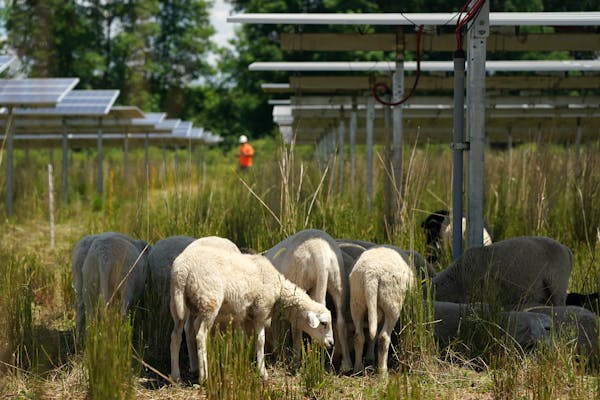Miners see gold in northern Minnesota concentrations of nickel, copper, cobalt and other minerals key to production of batteries for electric-powered vehicles and other equipment.
The recently passed federal Inflation Reduction Act provides billions in incentives to accelerate America's transition to a lower-carbon, renewable energy-powered economy.
The measure, signed into law this month by President Joe Biden, includes significant tax breaks for for wind, solar and battery developers. Added spending will be offset by a minimum corporate income tax and a beefed-up IRS charged with reducing the $500 billion annual "tax gap."
A provision of the 700-page law concerns some environmental groups, though.
Mining companies will be able to write off 10% of the cost of their operations if they produce "critical minerals" considered essential to national security and the economy and vulnerable to foreign supply-chain disruptions. As in mines in China, Russia and Africa.
The question: Will northern Minnesota, a hub for these metals, and the U.S. produce more of the nickel, copper and cobalt critical to a greener economy instead of outsourcing the work to other, often-unfriendly countries with lower environmental standards?
Talon Metals is developing the nickel-copper Tamarack project in northern Minnesota's Aitkin and Carlton counties in partnership with mining conglomerate Rio Tinto. Talon expects to file for related state permits early next year.
Todd Malan, Talon's chief external affairs officer and head of climate strategy, said the new law and the bipartisan-passed infrastructure law support "domestic supply chain for battery minerals" and that "the United States is blessed with significant sources of battery minerals like nickel, cobalt, lithium, manganese and iron and [will] provide significant support for domestic battery production from mine through recycling."
Minnesota has some of the richest concentrations of nickel in the country, noted Henry Miles, an environmentalist and retired securities-and-technology professional. A proponent of Talon's Tamarack mine, 50 miles west of Duluth, Miles also is a student of the mining-environmental battles in northeastern Minnesota.
He sees Talon as the most likely candidate to succeed. It's farther from the Boundary Waters Canoe Area Wilderness and Superior National Forest than the proposed mines of PolyMet and Twin Metals. Twin Metals abuts the BWCA and largely has gotten a thumbs down from regulators and environmental groups (and the company filed a lawsuit Monday over canceled leases). PolyMet's proposed project near Hoyt Lakes, the site of a former ore mine, seems to have a better chance.
All three are part of foreign mining conglomerates with past environmental issues.
Talon Metals, a public company, has received positive reviews from securities analysts and some geologists who cite its high-grade nickel deposits and location. It also signed a contract with Tesla.
Talon's Tamarack field, located near the tiny town of Tamarack, has communicated regularly with the public, including environmental groups and adjacent Indian tribes.
The nearby Sandy Lake Band of Mississippi Chippewa opposes the mine.
"That land is all swamp," said Chair Jean Skinaway-Lawrence, who said she fears mining waste-related pollution will end up in Sandy Lake and other waters. "We have treaties and covenants to protect our land and waters. This is our heritage. I'm going to have to put my body on the line."
The Minnesota Center for Environmental Advocacy is awaiting the environmental filings, consulting with tribes and the skeptical "Tamarack Water Alliance." The Sandy Lake band and others want the industry to do better at recycling battery materials and finding substitute materials. The industry says the demand for electric vehicles means mining.
"We respect tribal governments' duty to protect the environment in our region and their members' connection to the land," Malan said. "We are committed to providing information needed by tribal governments to participate in the … permitting process and seek their feedback on the environmental and cultural field studies that we are conducting.''
The Biden administration wants to significantly reduce transportation emissions, the top source of climate change-driving carbon dioxide, as the utility industry has decreased emissions from dirty coal to cleaner natural gas, wind and solar.
Talon Metals asserts that its so-called green nickel mining approach will have minimal environmental impact to air, land and water, including planned carbon capture and landscape remediation.
Talon Metals earlier this year struck a deal with EV maker Tesla to provide at least 75,000 metric tons of nickel concentrate over six years from Talon's planned mine in Tamarack. Talon hopes to open the mine by 2026.
Talon estimates the mine, processing and waste management operations will employ 400 workers in good-paying union jobs. It's engaged the community in discussions. It will present its case next year to regulators and stakeholders.
The bet here is that Minnesota will end up with at least one such mining operation. And it should be the global leader in environmental practices and remediation, as well as safe fuel for a greener, plug-in economy. We can't continue to rely on other countries, with suspect environmental and geopolitical interests, to do our often-dirty work for us.

St. Anthony: 'Patient' investing paying off for St. Paul's Hill Capital

Jennifer Smith, leader of Burnsville's Innovative Office Solutions, has died

St. Anthony: Medical professions in Minnesota need more people of color in their ranks





